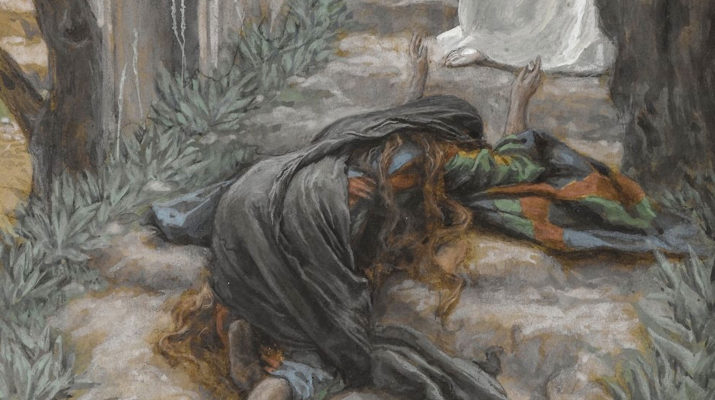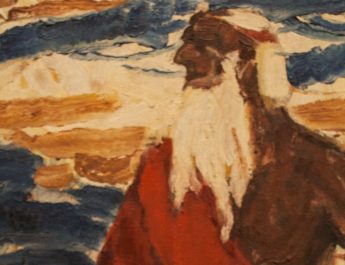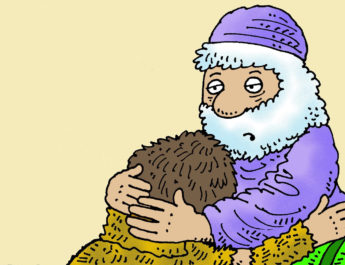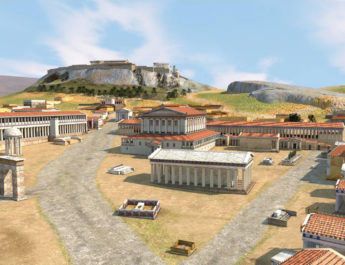John 20:1-2, 11-18
Feast of Mary Magdalene – A Women’s Lectionary
1 EarlyA on the firstB day of the week,C while it was still dark,D
A “early” = proi. 12x in NT. From pro (before, earlier than, ahead, prior). This is early, at dawn, during the daybreak watch.
B “first” = heis. This is one, a person, only, some.
C “week” = sabbaton. From Hebrew shabbath (sabbath); from shabath (to rest, stop, repose, cease working; by implication, to celebrate). This is the sabbath. It can also be used as shorthand for a week i.e. the time between two sabbaths.
D “dark” = skotia. 16x in NT. From skotos (darkness literal or figurative – as moral or spiritual darkness, sin and what comes from it; obscurity); from skia (shadow, thick darkness, outline; figurative for a spiritual situation that is good or bad). This is darkness or dimness. Figuratively, it can be a spiritual darkness. This is obscurity in a literal or figurative sense.
MaryE MagdaleneF cameG to the tombH
E “Mary” = Maria. From Hebrew Miryam (Aaron and Moses’s sister); from marah (to be contentious, rebellious, bitter, provoking, disobedient; to be or make bitter or unpleasant; figuratively, to rebel or resist; causatively to provoke). This is Miriam or Mary.
F “Magdalene” = Magdalene. 12x in NT. From Magdala (Magadan, a place near the Sea of Galilee); perhaps from Aramaic migdal, see also Hebrew migdal (tower); from gadal (to grow, grow up, be great). This is from Magdala.
G “came” = erchomai. This is to come, go.
H “tomb” = mnemeion. From mousikos (to remember); from mneme (memory or mention); from mnaomai (to remember; by implication give reward or consequence); perhaps from meno (to stay, abide, wait, endure). This is properly a memorial – a tomb, grave, monument.
and sawI that the stoneJ had been removedK from the tomb.
I “saw” = blepo. This is literally to see – it is primarily used in the physical sense. However, figuratively it can be seeing, which includes attention and so to watchfulness, being observant, perceiving, and acting on the visual information. It can also mean beware.
J “stone” = lithos. This is stone in a literal or figurative sense.
K “removed” = airo. This is to lift up in a literal or figurative sense. So, it could mean to lift, carry, or raise. It could also imply lifting something in order to take it away or remove it. Figuratively, this can be used for raising the voice or level of suspense. It can mean sailing off as raising the anchor. It can also correspond to a Hebrew expression for atonement of sin (lift/remove sin).
2 So she ranL and wentM to SimonN PeterO
L “ran” = trecho. 20x in NT. To run, make progress, rush. This is running like an athlete in a race. Figuratively, to work quickly towards a goal in a focused way.
M “went” = erchomai. Same as “came” in v1. See note G above.
N “Simon” = Simon. From Hebrew Shimon (Simon – Jacob’s son and his tribe); from shama (to hear, often implying attention and obedience). This is Simon, meaning “he who hears.”
O “Peter” = Petros. Related to petra (large rock that is connected and or projecting like a rock, ledge, or cliff; can also be cave or stony ground). This is Peter, a stone, pebble, or boulder.
and the otherP disciple,Q the one whom JesusR loved,S
P “other” = allos. This is other, another. Specifically, it is another of a similar kind or type. There is a different word in Greek that speaks of another as a different kind (heteros).
Q “disciple” = mathetes. From matheteuo (to make a disciple of); from manthano (to learn key facts, gain knowledge from experience; generally implies reflection as part of the learning process); from math– (thinking things through). This is a disciple, learner, or student. It is where we get “mathematics” from.
R “Jesus” = Iesous. From Hebrew Yehoshua (Joshua, the Lord is salvation); {from YHVH (proper name of the God of Israel; the self-existent and eternal one); {from havah (to become) or from hayah (to come to pass, become, be)} + yasha (to deliver, defend, help, preserve, rescue; properly, to be open, wide or free, which implies being safe. So, in a causative sense, this is to free someone)}. This is Jesus or Joshua in Greek – the Lord saves or the Lord is salvation.
S “loved” = phileo. From philos (dear, beloved, a friend, an associate; friendship with personal affection, a trusted confidante; love from personal experience with another person). This is friendship love and fondness with personal attachment.
and said to them, “They have takenT the LordU out of the tomb, and we do not knowV where they have laidW him.”
T “taken” = airo. Same as “removed” in v1. See note K above.
U “Lord” = Kurios. From kuros (authority, supremacy). This is a respectful address meaning master or sir. It refers to one who has control or power greater than one’s own. So, it was also applied to God and Jesus as Master or Lord.
V “know” = eido. This is to know, consider perceive, appreciate, behold, or remember. It means seeing with one’s eyes, but also figuratively, it means perceiving – seeing that becomes understanding. So, by implication, this means knowing or being aware.
W “laid” = tithemi. This is to put, place, set, fix, establish in a literal or figurative sense. Properly, it is placing something in a passive or horizontal position.
11 But Mary stoodX weepingY outside the tomb. As she wept, she bent over to lookZ into the tomb,
X “stood” = histemi. This is to stand, place, establish, appoint, stand ready, be steadfast.
Y “weeping” = klaio. This is to weep, lament, or sob. It is weeping aloud.
Z “bent over to look” = parakupto. 5x in NT. From para (by, beside) + kupto (to stoop, bend forward, bow one’s head); perhaps from kuma (wave, billow, curve, bend); from kuo (to swell as one pregnant). This is to bend beside or stoop. To bend over to peer into.
12 and she sawAA twoBB angelsCC in whiteDD
AA “saw” = theoreo. From theaomai (to behold, look upon, see, contemplate, visit); from thaomai (to gaze at a spectacle; to look at or contemplate as a spectator; to interpret something in efforts to grasp its significance); from theoros (a spectator or envoy). This is gazing, beholding, experiencing, discerning. It is looking at something to analyze it and concentrate on what it means. This is the root of the word “theatre” in that people concentrate on the action of the play to understand its meaning.
BB “two” = duo. This is two or both.
CC “angels” = aggelos. Probably from ago (to lead, bring, carry, guide) + agele (flock, herd, drove); {also from ago (see above)}. This is angel or messenger. Properly, it is one sent with news or to perform a specific task. This messenger can be human or an angel from heaven. More commonly, it is used for angels in the New Testament.
DD “white” = leukos. Related to luke (light). This is bright, white, or brilliant.
sittingEE where the bodyFF of Jesus had been lying,GG oneHH at the headII and the otherJJ at the feet.KK
EE “sitting” = kathezomai. 7x in NT. From kata (down, against, according to, among) + hezomai (to sit); {from aphedron (a seat, a base). This is to sit down or be sitting.
FF “body” = soma. Perhaps from sozo (to save, heal, rescue); from sos (safe, well, rescued). This is body or flesh. It can be body in a literal or figurative sense (as the body of Christ). This is where the word “somatic” comes from.
GG “lying” = keimai. This is to lie, recline, be set, appointed, destined. It is to lie down literally or figuratively.
HH “one” = heis. Same as “first” in v1. See note B above.
II “head” = kephale. This is head or chief. It can be a literal head or, figuratively, a ruler or lord. It can also refer to a corner stone. This is where the word “cephalic” comes from.
JJ “other” = heis. Same as “first” in v1. See note B above.
KK “feet” = pous. This is foot literal or figurative.
13 They said to her, “Woman,LL why are you weeping?”
She said to them, “They have taken away my Lord, and I do not know where they have laid him.” 14 When she had said this, she turnedMM aroundNN and sawOO Jesus standing there, but she did not know that it was Jesus.
LL “woman” = gune. Perhaps from ginomai (to come into being, to happen, become, be born; to emerge from one state or condition to another; this is coming into being with the sense of movement or growth). This is woman, wife, or bride. This is where the word “gynecologist” comes from.
MM “turned” = strepho. From trope (turning, shifting, a revolution; figuratively, a variation); from trepo (to turn). This is to turn, change, turn back, be converted; to turn around completely to take the opposite path or a completely different one.
NN “around” = opiso. From the same as opisthen (after, back, from the rear); probably from opis (back); from optanomai (to appear, be seen); perhaps from horao (become, seem, appear). This is back, behind, after.
OO “saw” = theoreo. Same as “saw” in v12. See note AA above.
15 Jesus said to her, “Woman, why are you weeping? Whom are you looking for?”PP
SupposingQQ him to be the gardener,RR she said to him, “Sir,SS if you have carried him away,TT tell me where you have laid him, and I will take him away.”
PP “looking for” = zeteo. This is to seek, search for, desire. It is searching for something by inquiring or investigation. It can be seek in a literal or figurative sense. There is a Hebrew figure of speech “to seek God’s face” so it can also mean to worship God. Alternately, you could seek someone’s life i.e. plot to kill them.
QQ “supposing” = dokeo. From dokos (opinion). This is to have an opinion, seem, appear, think, suppose. It deals with a personal judgment. This is the root of the word “doxology.”
RR “gardener” = kepouros. 1x in NT. From kepos (garden with trees or herbs) + ouros (watcher). This is literally garden-keeper.
SS “sir” = kurios. Same as “Lord” in v2. See note U above.
TT “carried…away” = bastazo. Perhaps from the base of basis (step, hence foot; a pace); from baino (to walk, to go). This is to lift in a literal of figurative sense. It can also mean take up, carry, bear, or remove. Figuratively, it can mean declare, endure, or sustain.
16 Jesus said to her, “Mary!”
She turned and said to him in Hebrew,UU “Rabbouni!”VV (which means Teacher).WW
UU “in Hebrew” = Hebraisti. 7x in NT. From Hebrais (Hebrew language, Aramaic); from Eber (Heber); from Hebrew Eber (the region beyond; Eber, the name of several Israelites including a descendant of Shem); from abar (to pass over, pass through, or pass by; cross over or to alienate; used for transitions). This is Hebrew, perhaps meaning a descendant of Eber. This is in Hebrew or in Aramaic.
VV “Rabbouni” = Rhabbouni. 2x in NT. From rhabbi (a title of respect for a teacher-scholar; literally, great one or honorable sir; also my master or my teacher); from Hebrew rab (chief); from rabab (to be many, increase, multiply). This is Rabbi, Lord, my master, my teacher in Aramaic.
WW “Teacher” = didaskalos. From didasko (to teach, direct, instruct, or impart knowledge; in the New Testament, almost always used for teaching scripture); from dao (to learn). This is teacher or master.
17 Jesus said to her, “Do not touchXX me, because I have not yet ascendedYY to the Father.ZZ
XX “touch” = haptomai. From hapto (to touch, handle, kindle, lay hold of). This is a touch that has an impact on what is being touched – it has an influence on the recipient so that the recipient is changed.
YY “ascended” = anabaino. Related to “carried…away” in v15. From ana (up, back, among, again, anew) + the same as basis (see note TT above). This is to come up in a literal or figurative sense – ascent, rise, climb, enter.
ZZ “Father” = pater. This is father in a literal or figurative sense. Could be elder, senior, ancestor, originator, or patriarch.
But goAAA to my brothersBBB and say to them, ‘I am ascending to my Father and your Father, to my GodCCC and your God.’”
18 Mary Magdalene went and announcedDDD to the disciples, “I have seenEEE the Lord,” and she told them that he had said these things to her.
AAA “go” = poreuomai. From poros (ford, passageway). This is to go, travel, journey, or die. It refers to transporting things from one place to another and focuses on the personal significance of the destination.
BBB “brothers” = adelphos. From a (with, community, fellowship) + delphus (womb). This is a brother in a literal or figurative sense. It is also used of another member of the Church.
CCC “God” = Theos. From Proto-Indo-European origins, meaning do, put, place. This is God or a god in general.
DDD “announced” = apaggello. Related to “angels” in v12. From apo (from, away from) + aggello (to announce, report); {from aggelos (see note CC above)}. This is to report, declare, bring word. It is an announcement that emphasizes the source.
EEE “seen” = horao. Related to “around” in v14. See note NN above.
Image credit: “Touch Me Not” by James Tissot, between 1886 and 1894.




